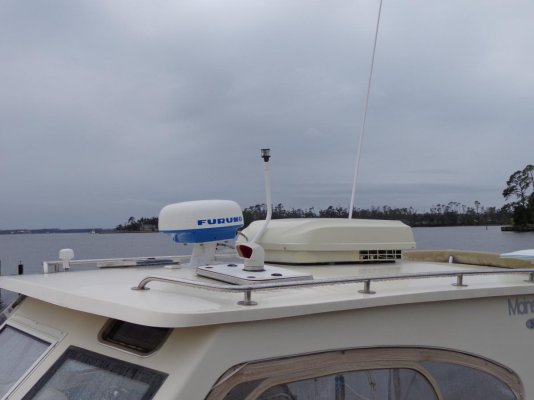janice142
Guru
- Joined
- Oct 12, 2011
- Messages
- 1,239
- Location
- USofA
- Vessel Name
- Seaweed
- Vessel Make
- Schucker mini-trawler
Seaweed needs a "real" ac versus the wall-banger I've been using for several years. I picked the new (to me) 13.5k btu unit from Dometic. The one I chose was lighter weight (70 pounds) than the standard version that is over 100 poundss. Another bonus is that it fits between the two Bucky solar panels.
So I ordered it from http://rvpartscountry.com
Deep breath... tale of woe follows.
The bottom half (controls) arrived fine. The upper part, along with the heating element (missing that part) was dropped off. The box was open. Plastic that normally covers the unit was under it. Item arrived on its side. All four sides of the box said THIS SIDE UP with arrows.
Nope. My concern was that this thing sat on edge for the entire transport and vibration killed something inside. I'd paid for extra insurance to make sure there were no problems. Company wanted pictures. In process of doing that something was rattling inside.
They did accept the return. I have not received a refund. Yet.
So...
#1) Do I attempt to purchase a duplicate, or get one (if possible) from http://rvpartscountry.com ? I do have the serial number so they cannot send me back the same one even if they remove whatever rattled.
Do I look for one from another seller?
IMPORTANT to know. The 13.5 is being discontinued, replaced with a 15k. The price for the compete 13.5 (albeit broken) was $900. I've been quoted $1400 for the 15k and am not certain that includes the inside controls.
So, do I continue with what is essentially an obsolete unit... IF I can even locate same? Do I wait for Dometic to get the 15k in stock (possibly August)
I do not know the footprint of the 15 version. If it is wider it won't fit between the solar panels. ARGH.
So what should I do? At time of ordering I did not know the 13.5 was being discontinued. The 15k is $500 more, though I do not want to be penny wise and pound foolish.
What would you do if you were me? And thanks for reading this.
So I ordered it from http://rvpartscountry.com
Deep breath... tale of woe follows.
The bottom half (controls) arrived fine. The upper part, along with the heating element (missing that part) was dropped off. The box was open. Plastic that normally covers the unit was under it. Item arrived on its side. All four sides of the box said THIS SIDE UP with arrows.
Nope. My concern was that this thing sat on edge for the entire transport and vibration killed something inside. I'd paid for extra insurance to make sure there were no problems. Company wanted pictures. In process of doing that something was rattling inside.
They did accept the return. I have not received a refund. Yet.
So...
#1) Do I attempt to purchase a duplicate, or get one (if possible) from http://rvpartscountry.com ? I do have the serial number so they cannot send me back the same one even if they remove whatever rattled.
Do I look for one from another seller?
IMPORTANT to know. The 13.5 is being discontinued, replaced with a 15k. The price for the compete 13.5 (albeit broken) was $900. I've been quoted $1400 for the 15k and am not certain that includes the inside controls.
So, do I continue with what is essentially an obsolete unit... IF I can even locate same? Do I wait for Dometic to get the 15k in stock (possibly August)
I do not know the footprint of the 15 version. If it is wider it won't fit between the solar panels. ARGH.
So what should I do? At time of ordering I did not know the 13.5 was being discontinued. The 15k is $500 more, though I do not want to be penny wise and pound foolish.
What would you do if you were me? And thanks for reading this.

